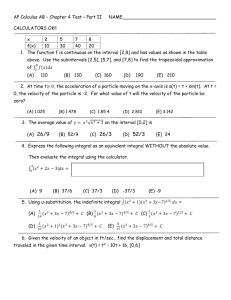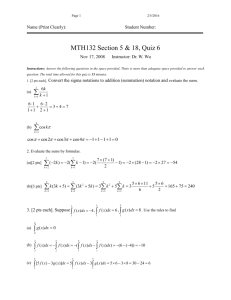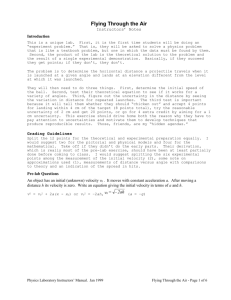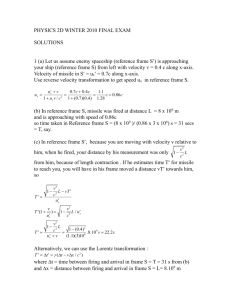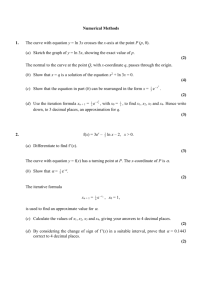AP Calculus Problem Set (worth 100 points) 1/27/12
advertisement
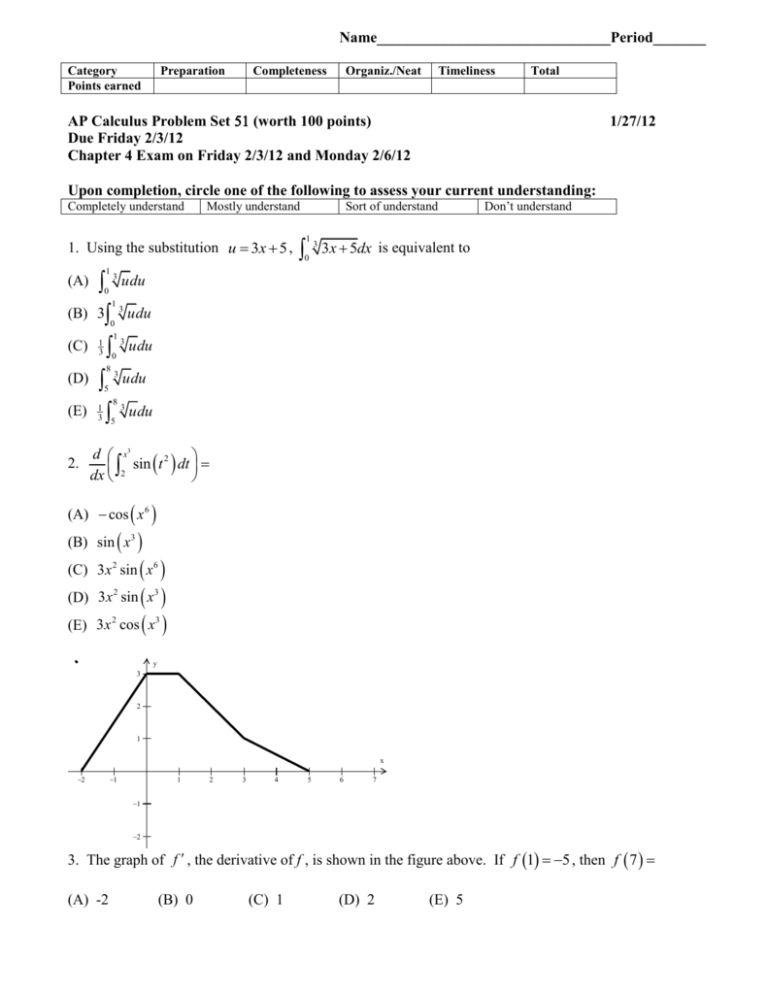
Name_______________________________Period_______ Category Points earned Preparation Completeness Organiz./Neat Timeliness Total AP Calculus Problem Set (worth 100 points) Due Friday 2/3/12 Chapter 4 Exam on Friday 2/3/12 and Monday 2/6/12 1/27/12 Upon completion, circle one of the following to assess your current understanding: Completely understand Mostly understand 1. Using the substitution u 3x 5 , (A) (B) (C) (D) (E) 2. 1 3 3 0 1 1 0 3 Don’t understand 3x 5dx is equivalent to udu 3 udu 3 1 3 0 8 3 udu 0 1 5 Sort of understand udu 8 3 1 3 5 udu d x3 2 2 sin t dt dx (A) cos x 6 (B) sin x 3 (C) 3x 2 sin x 6 (D) 3x 2 sin x3 (E) 3 x 2 cos x 3 y x 3. The graph of f , the derivative of f , is shown in the figure above. If f 1 5 , then f 7 (A) -2 (B) 0 (C) 1 (D) 2 (E) 5 y A C x B 4. The regions A, B, and C in the figure above are bounded by the graph of the function f and the x-axis. If the areas of these regions are 11, 23, and 5 respectively, what is the value of f x 2dx 7 4 (A) -7 (B) 7 (C) 15 (D) 39 (E) 61 5. If a trapezoidal sum underapproximates f x dx , and a left Riemann sum overapproximates 5 0 f x dx which of the following could be the graph of 5 0 (A) y f x ? (B) (C) y y y (D) x x x (E) y y x x 6. A particle moves along the y-axis so that at any time t 0 , its acceleration is given by a t 3 2t 3 . If the velocity of the particle is 4 at time t 1, then what is the velocity of the particle at time t 15 ? (A) 24 (B) 34 (C) 44 (D) 54 (E) 64 7. Let g be the function given by g x t 2 10t 24dt . On which of the following intervals is x 0 g decreasing? (A) 4 x 6 (B) 4 x 6 (C) 6 x 4 (D) 2 x 12 (E) 12 x 2 8. (A) 1 x dx 3 1 C 2 x2 (B) (C) 1 C 2x2 1 C 4 x4 (D) 1 C 4x4 (E) x4 C 4 9. cos 3x sin 3x dx (A) 3sin 3x 3cos 3x C (B) 3sin 3x 3cos 3x C 1 1 (C) sin 3 x cos 3 x C 3 3 (D) 1 1 sin 3 x cos 3 x C 3 3 (E) 1 1 sin 3 x cos 3 x C 3 3 t 10. A particle moves along the x-axis with velocity given by v t sin for time t 0 . If the 3 particle is at position x 3 at time t 0 , what is the position of the particle at time t 2 ? 9 2 (A) 3 (B) 9 2 (C) 3 3 2 (D) 3 3 2 (E) 7 2 11. If f x dx 12 and f x dx 8 , what is the value of f x dx 4 4 7 3 7 3 (A) - 20 (B) - 4 (C) 0 (D) 4 (E) 20 y x 12. The graph of the piecewise linear function f is shown in the figure above. If g x f t dt , x 3 which of the following values is greatest? (A) g 5 (B) g 2 (C) g 0 (D) g 2 (E) g 7 y x 13. The graph of the function f is shown above for 0 x 5 . Of the following, which has the least value? (A) f x dx 5 1 f x dx with 8 subintervals of equal length (C) Right Riemann sum approximation of f x dx with 8 subintervals of equal length (D) Midpoint Riemann sum approximation of f x dx with 8 subintervals of equal length (E) Trapezoidal sum approximation of f x dx with 8 subintervals of equal length 5 (B) Left Riemann sum approximation of 1 5 1 5 1 5 1 y x 14. The graph of the function f shown above has horizontal tangents at x 3 and x 6 . Let g be the function defined by g x f t dt . For what values of x does the graph of g have a point of x 0 inflection? (A) 3 only (B) 5 only (C) 6 only (D) 3 and 6 only (E) 3, 5, and 6 only x -5 -4 -3 -2 f x 1 -2 -4 -6 f x -3 -1 0 2 15. The table above gives values of a function f and its derivative at selected values of x. If f is continuous on the interval 5, 2 , what is the value of (A) -7 (B) -5 (C) -1 (D) 5 (E) 6 2 5 f x dx ? 16. t (seconds) v t (feet per second) 0 10 20 30 40 50 60 70 80 6 15 23 30 34 41 42 46 50 A rocket has a positive velocity v t after being launched upward from an initial height of 0 feet at time t 0. a) Approximate v t dt 70 10 using a left Riemann sum, a right Riemann sum, a midpoint Riemann sum and a trapezoid sum with 3 subintervals of equal length. b) Using correct units, explain the meaning of v t dt 70 in terms of the rocket’s flight. 10 c) Use your midpoint Riemann sum approximation from part a) to approximate the average velocity of the rocket over the time interval 10 t 70 . d) Find the average acceleration of the rocket over the time interval 10 t 80 Find the average value of the function on the given closed interval. 17. f ( x) 6 x 2 5 x 1, 2 18. f ( x) 3 2 x 1 5,13 4 dt . 3t 1 a) What is the average velocity of the object from time t = 0 to time t = 3? b) What is the average acceleration of the object from time t = 0 to time t = 3? 19. The velocity of an object traveling in a straight line is given by v t 3 20. Given the graph of a function f is shown below, find the average value of f (x) on the interval 8,8 y x 21. Given the graph of a function f is shown below, find the average value of f (x) on the interval 11,9 y x 22. The table below gives the values of a function f , a twice-differentiable function, and its first and second derivative at selected values of x. -4 -3 -2 -1 0 1 2 3 4 x 10 8 7 2 -1 -4 -3 0 1 f x f x -6 -3 0 1 5 9 6 3 2 f x 0 2 5 11 9 7 2 -3 -7 a) What is the average rate of change of f over the interval 4, 2 ? b) What is the average rate of change of f , the derivative of f , over the interval 1, 2 ? Evaluate the indefinite integral. 23. 3x 5 2x 3 x dx 4 x x dx 1 5 dx 25. x x 3 24. 3 26. 8x 2 4 x 5 x 4 dx 5x 1dx 28. x x 1dx 29. (4x 1)(4 x 2x 7) dx 30. cos 4 x sin 4 x dx 3 27. 2 3 2 2 3 dx 5x 1 32. (3sec x tan x 2 csc 2 x 5sec 2 x csc x cot xdx 31. Evaluate the definite integral. 2 2 33. 1 2 dx 1 x 1 x2 34. dx 0 (1 x 3 ) 4 4 3x dx 35. 0 x2 9 36. 3 0 3sin x 2cosx dx 37. Find the particular solution y f x to the given differential equation with the initial condition f 3 2 dy 2 x 1 dx y3 38. Find the particular solution y f x to the given differential equation with the initial condition f 2 9 dy 4x y dx 39. Given h 8 at time t 3 where h is the height, in feet, of the water in the center of a lake and t is the time, in days, solve the differential equation dh 3t 2 dt 3 h for h as a function of t . 40. Let v t be the velocity, in meters per second, of a skydiver at time t seconds. The velocity of the dv 5 with initial condition v 2 3 . Find an expression dt v skydiver satisfies the differential equation for v in terms of t. 41. Given a) b) c) d) 6 4 f (x)dx 5 and f (x)dx f (x)dx 8 f (x)dx f x 3dx 1 6 f (x)dx 8 , evaluate: 1 4 6 1 4 6 4 1 42. Given f (x) is an odd function and c) d) 3 f ( x) 2 dx a) b) 12 12 d) e) f ( x) 4x dx c) f (x)dx 0 3 0 3 3 10 10 3 12 0 f (x)dx 3 , evaluate: f (x)dx 8 5 b) 5 f (x)dx 12 8 43. Given f (x) is an even function and a) f (x)dx 7 and f (x)dx 5 0 8 0 f (x)dx f (x)dx f (x)dx 8 Simplify. d x 4t 2 dt 44. dx 3 sin t 45. d dx 46. d dx t 47. d cos x 3 2 t 4t 7 dt 1 dx 2x 0 5 x2 t 3 cos tdt t 3 3t 4dt 8 0 f (x)dx 6 and 3 0 f (x)dx 4 , evaluate: For problems 48-50, find g x 48. g x t 3 sin tdt 49. g x 4 1 2 x3 x 50. g x t 2 cos tdt 5 x2 3 t 3 sin t 2 dt 51. If f x 3x 2 2 and f 1 3 , then f 4 52. If f x 2 3x 1 and f 0 6 , then f 5 y x 53. The graph of f , the derivative of f , is shown in the figure above. If f 2 3 , then find the following: a) f 6 d) f 4 b) f 8 e) f 8 c) f 0 f) f 2 54. The rate of change of the amount of snow on the roof of a house, in cubic feet per hour, is given by r t t 3 4t for 0 t 5 . Determine the change in amount of snow during the time the amount of snow is decreasing. 55. A kettle of water, heated to a temperature of 95 degrees Celsius ( C ), is taken off the stove at time t = 0 minutes. The temperature of the water in the kettle is changing at a rate of 5 4 t degrees Celsius per minute.To the nearest degree, what is the temperature of the water in the kettle at time t = 16 minutes? 56. A spherical snowball melts as the temperature rises. The table below gives selected values of the rate of change of the radius of the snowball over the time interval 0 t 24 . t (hours) 0 4 8 12 16 20 24 -3 -1 -5 -2 -4 -7 -10 r t (mm per hour) a) Using correct units, explain the meaning of r t dt 24 0 in the context of this problem. b) Use a left Riemann sum with six subintervals of equal width to approximate r t dt . 24 0 1 24 r t dt in the context of this problem. c) Using correct units, explain the meaning of 24 0 1 24 r t dt . d) Use a midpoint Riemann sum with three subintervals of equal width to approximate 24 0 57. The rate of fuel consumption, in liters per minute, by a truck hauling cargo is given by a twicedifferentiable and strictly decreasing function A of time t. A t 0 for all t. A table of selected values of A t , for the time interval 0 t 120 , is shown below. A t (liters per minute) 20 15 12 9 7 6 t (minutes) 0 10 30 60 95 120 a) Using correct units, explain the meaning of b) Approximate the value of 120 0 120 0 A t dt in the context of the problem. A t dt using a trapezoidal sum with the five subintervals indicated by the data in the table. Is this approximation less than the value of 120 0 A t dt ? Justify your answer c) Use a right Riemann sum with the five subintervals indicated by the data to approximate Is this approximation less than the value of 120 0 120 0 A t dt A t dt ? Justify your answer. v(t) t 58. A ground squirrel begins at time t = 0 and travels in a straight path in order to cross a road. For 0 t 30 , the squirrel’s velocity, v(t) , in cm per second, is modeled by the piecewise-linear function shown in the graph above. a) After beginning, the squirrel changes direction to avoid being run over by a car. At what time does the squirrel change direction? Give a reason for your answer. b) Does the squirrel ever return to his starting point? Give a reason for your answer. c) Find the total distance the squirrel travels during the time interval 0 t 30 . d) At what time is the squirrel farthest from his starting point? How far from the starting point is the squirrel at that time? e) At t 9 t 17 , and t 20 find the acceleration of the squirrel or explain why it does not exist. f) At t 14 , is the squirrel speeding up, slowing down, or neither. Justify your answer. g) At t 21 , is the squirrel speeding up, slowing down, or neither. Justify your answer. h) Write expressions for the squirrel’s acceleration a t , velocity v t , and distance x t from the starting point that are valid for the time interval 16 t 25 . i) Suppose a hedgehog also begins at time t = 0 and travels in a straight path in order to cross the same road as the squirrel. For For 0 t 25 , the hedgehog’s velocity, in cm per second, is modeled by V t 2 . Who travels t further the squirrel or the hedgehog? Show the work that leads to your answer. x 59. Given the graph of f (t) below and g ( x) f (t )dt 3 v(t) t g 4 g 0 g 0 g 4 g 5 g 0 g 8 g 4 a) On what interval(s) is g increasing? b) On what interval(s) is g decreasing? c) On what interval(s) is the graph of g concave up? d) On what interval(s) is the graph of g concave down? e) Find the coordinates of any relative maximums of g(x) f) Find the coordinates of any relative minimums of g(x) g) Find the absolute maximum value of g(x) on 6,8 At what x-value does it occur? h) Find the absolute minimum value of g(x) on 6,8 At what x-value does it occur? i) Find the coordinates of any points of inflection of g(x) j) Find the average value of g(x) on 6, 2 k) Find the average value of g(x) on 4,0
